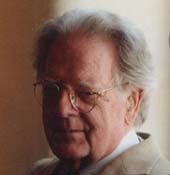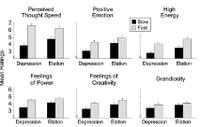Ordering Our Chaos

“The human word is neither immortal nor invulnerable; but it is the power that orders our chaos, and the light by which we live.”
–Northrop Frye (Canadian Literary Critic, 1912-1991)
Music, Language and the Brain

For more than two centuries neurologists and others interested in music and language have wondered whether or not language and music depend on common processes in the mind. It has been known that some aspects of language and music are represented in different regions of the brain, but there are also many areas of crossover.
Now, researchers at Georgetown University Medical Center have published evidence in the journal NeuroImage, that the processing of music and language do indeed depend on some of the same brain systems.
Their findings suggest that two different aspects of both music and language depend on the same two memory systems in the brain. One brain system, based in the temporal lobes, helps us to memorize information in both language and music, for example words and meanings in language and familiar melodies in music. The other memory system is focused in the frontal lobes, and this one helps us to learn “unconsciously” and use the rules that underlie both language and music, such as the rules of syntax in sentences, and the rules of harmony in music.
The study involved 64 adults and the researchers used a technique called event-related potentials, in which they measured the brain’s electrical activity using electrodes placed on the scalp.
The subjects listened to 180 snippets of melodies. Half of the melodies were segments from tunes that most participants would know, such as “Three Blind Mice” and “Twinkle, Twinkle Little Star.” The other half included novel tunes composed by one of the researchers. Three versions of each well-known and novel melody were created: melodies containing an in-key deviant note that could only be detected if the melody was familiar, and therefore memorized; melodies that contained an out-of-key deviant note that violated rules of harmony; the original melodies that acted as the “controls”
They found that violations of rules and memory in music corresponded to the two patterns of brain waves seen in previous studies of rule and memory violations in language. In-key violations of familiar melodies led to a brain-wave pattern similar to one called an “N400” that has previously been found with violations of words. One example that the authors gave: :I’ll have my coffee with milk and concrete.” Out-of-key violations of both familiar and novel melodies generated electrical activity over the frontal lobe similar to the patterns previously found for violations of rules in both language and music. Out-of-key violations of familiar melodies also led to an N400-like pattern of brain activity, as expected because these are violations of memory as well as rules.
This research opens up new ways of thinking about the relationships between language and music, and may have implications for speech and language therapy.
“When I hear music, I fear no danger. I am invulnerable. I see no foe. I am related to the earliest times, and to the latest.”
–Henry David Thoreau (American Essayist and Philosopher, 1817-1862)
“There is nothing better than music as a means for uplifting the soul.”
–Hazrat Inayat Khan (Founder of the Sufi Order of the West, 1882-1927)
“There are more love songs than anything else. If songs could make you do something we’d all love one another.”
–Frank Zappa (American Composer, Guitarist, Satirist and Song Writer, 1940-1993)
“Since music is a language with some meaning at least for the immense majority of mankind, although only a tiny minority of people are capable of formulating a meaning in it, and since it is the only language with the contradictory attributes of being at once intelligible and untranslatable, the musical creator is a being comparable to the gods, and music itself the supreme mystery of the science of man, a mystery that all the various disciplines come up against and which holds the key to their progress.”
–Claude Lévi-Strauss (Belgian-born French Social Anthropologist, 1908-)
Rewiring the Dyslexic Brain

Dyslexia can be a real difficulty for many children, although for many it has been a gift: they have succeeded very well in life by mobilizing other psychological and neurological resources. Sir Richard Branson, the founder of Virgin Enterprises, Thomas Edison and Albert Einstein are all said to have had dyslexia.
There are many types of dyslexia, but in the most common – developmental dyslexia – children confuse letters and syllables when they read.
It now appears that some children with dyslexia struggle to read because their brains are not correctly wired to process fast-changing sounds, according to a study published this month in the journal Restorative Neurology and Neuroscience.
However sound training using computer exercises was able to rewire children’s brains, correcting the sound processing problem and improving reading.
More than 30 years ago Paula Tallal of Rutgers University proposed that children with dyslexia might have an underlying problem processing sound, but it has never been tested using brain imaging. The researchers used functional MRI imaging (fMRI) to examine how the brains of twenty two 9- to 12-year old children with developmental dyslexia, and normal readers, responded to sounds, both before and after using educational software called Fast ForWord Language.
The first test involved measuring how the children’s brains responded to either fast-changing or slow-changing sounds that resembled speech. The fast-changing sounds altered in pitch or other acoustic qualities quickly. In just tens of milliseconds, as occurs in normal speech. The slow-changing sounds changed over only hundreds of milliseconds.
In normal readers, 11 brain areas became more active when the children listened to fast changing, compared to slow changing, sounds. In dyslexic children, the fast-changing sounds did not stimulate high levels of activity in these regions of the brain. Instead, dyslexic children processed the fast-changing sounds as if they were slow changing. They used the same regions of the brain but at lower intensity.
We know that infants must correctly process fast-changing sounds as they learn language. They use sound processing to create a sound map of their native language. If they are unable to analyze fast-changing sounds, their sound map may become confused. The idea is that they run into trouble when they first see printed letters because the children’s brains now try to match their internal sound map to letters that they see on the page. Linking normal letters to confused sounds may lead to syllable-confused reading.
But the brains of the children with dyslexia changed after completing exercises in a computer program known as
The Fast ForWord Language program does not involve reading at all, but only listening to sounds, starting with simple, changing noises, like chirps that swooped up in pitch. The children then have to respond with a clicker when the chirp’s pitch goes up or down. At first the sounds are played slowly, but they gradually speed up, becoming more challenging for dyslexic children. The exercises are then repeated with increasingly complex sounds: syllables, words, and finally, sentences.
The fMRI study showed that these repetitive exercises appeared to rewire the dyslexic children’s brains: after eight weeks of daily sessions – about 60 hours in total – their brains responded more like the brains of typical readers when they were processing fast-changing sounds, and at the same time their reading improved.
It is still early days for this research, and we do not yet know whether the improvements in reading and in the brain will be sustained.
This research may make it possible to identify children at risk of dyslexia even before they start learning to read. It is also possible that other approaches to learning sounds, such as learning to sing or play an instrument may be effective, since most of us learn music with gradual, repetitive, and intense listening and move up to faster changing sounds.
The Speech Field

If you think about it, our remarkable ability to receive and decode speech is a biological miracle of the first order. The more so because it appears that we have only learned the trick in the last 50-100,000 years.
I have commented before about the importance of looking at entire brain systems rather than individual spots in the brain or individual brain cells. The brain is supposed to operate as a unified whole. If it doesn’t things are going wrong. Another concept, and one that is not widely known outside of neuroscience community, is that instead of thinking about a stimulus causing a set of neurons to fire, it is better to think about stimuli modulating the activity pattern of neural circuits that are already active.
Think of the appearance f a TV screen when the set isn’t tuned to a particular station. You get a fast moving “snow” effect. It is only when a coherent signal arrives that the “snow” gets itself organized.
Now colleagues from the University of Maryland have published some new data which may help explain how we discriminate speech, and why sometimes it can go wrong.
It appears that a particular resonance pattern in the brain’s auditory processing region appears to be the key.
Huan Luo and David Poeppel found that the inherent rhythm of neural activity called “theta band” specifically reacts to spoken sentences by changing its phase. The researchers also noted that the natural oscillation of this frequency provides further evidence that the brain samples speech segments about the length of a syllable.
The findings represent the first time that such a broad neural response has been identified as central to perceiving the highly complex dynamics of human speech. Previous research studies have looked at the responses of individual neurons to speech sounds, but not the response of the auditory cortex as a whole.
In their experiments, the researchers asked volunteers to listen to spoken sentences. One example was, “He held his arms close to his sides and made himself as small as possible.”
At the same time, the subjects’ brains were scanned using magnetoencephalography. In this imaging technique, sensitive detectors are used to measure the magnetic fields produced by electrical activity in brain regions.
The theta band oscillates between four and eight cycles per second, and it changes its phase pattern with unique sensitivity and specificity in response to the spoken sentences. As a second experiment, when the experimenters degraded the intelligibility of the sentences, the theta band pattern lost its tracking resonance with the speech.
The researchers said their findings suggest that the brain discriminates speech by modulating the phase of the continuously generated theta wave in response to the incoming speech signal.
Second, looking at the time-dependent characteristics of this theta wave suggest that the brain samples the incoming speech in “chunks” that are about the length of a syllable from any given language.
When you hear something, it goes from your ears to your brain where fields begin to sample what you are hearing. From that you decode the message and turn into something that you can understand, and you make the decision on whether or not you need to act.
It’s remarkable what’s going on under the hood!
Thinking Speed, Mood and Optimism

There’s a very interesting article at the Mixing Memory blog. It’s one of the blogs that I highlight in the “What I’m reading” section. The articles highlights some recent research by Emily Pronin and Dan Wegner from Princeton and Harvard respectively, entitled “Manic Thinking: Independent Effects of Thought Speed and Thought Content on Mood.”
It’s about an intriguing issue. People who have a manic illness have an acceleration of thinking processes together with elevated mood and energy level. Mania is also associated with racing thoughts grandiose or creative ideas, fast, uninterruptible speech, aimless pacing, irritability and an over-involvement in pleasurable activities, together with a loss of impulse control.
It may sound great, and initially people are often very happy to be manic. But after a while it can give way to exhaustion or the realization that some of their choices have been unwise. I once knew someone who was driving a brand new BMW – that she could definitely not afford – at over 120 miles an hour, the wrong way down Interstate 95. That’s when the police became involved, and they immediately realized that she was not a villain, but a very sick person who could have killed herself and a ton of other people.
The researchers they had a group of college undergraduates read a series of 58 emotion-inducing statements out loud, and to do it at either a fast or slow pace. The statements are emotionally neutral at the beginning and then become progressively more emotionally positive or negative. The idea is that reading a series of progressively more positive or negative statements will affect the reader’s mood. The letters in the statements were presented one at a time, either for 40 milliseconds per letter (“fast thinking” condition) or 170 milliseconds per letter (“slow thinking”). A pilot study indicated that the 40 milliseconds per letter reading time were about twice the normal reading speed for college undergraduates and 170 milliseconds were about half the normal speed. The time between statements also varied, with only 320 milliseconds between statements in the “fast condition” and 4 seconds between statements in the “slow condition.”
After reading all 58 statements, the participants were asked to answer a series of questions designed to assess their mood, energy level, feelings of power, creativity and inspiration. There were also questions to evaluate “grandiosity or inflated self-esteem,” together with their own perceptions of their speed of thought.
Subjects in the “fast thought” condition reported faster thought speeds than those in the “slower” condition. As predicted, faster thought speeds affected mood and mania-related feelings, participants in the fast thought condition reported being happier, had higher energy levels, experienced greater senses of power and creativity, and higher levels of grandiosity (though self-esteem did not differ between conditions). What is important, is that these effects were independent of the mood manipulation (positive or negative statements). Here is a graph from the paper presenting the effects of slow and fast thinking as a function of the type of sentence:

This study has some important implications. Thinking more quickly produces elevations of mood and self-perception that can smetimes be similar to those of very mild mania. I have seen this happen frequently when people have been up all night: the bright lights of morning and a few cups of coffee make them appear mildly manic. For a time they do in fact impress with their creativity and mastery not only of details, but of the “Big picture.” But as time goes on, much of their thinking turns out to be not altogether logical.
The study also raises the possibility that some manic symptoms may be produced by thinking. There is an old term from the psychoanalytic literature called “manic defense,” in which people use manic-like symptoms to protect themselves – or more accurately their ego structures – when under stress.
I have spent most of my life with people who think very quickly and accurately. Most also express themselves very well: both succinctly and fluently. But all have also known the importance of stopping for a while after a brainstorming session, so that we can see if our ideas have really born fruit, or if they just seemed a good idea at the time.
There is no question that moving and speaking more quickly can elevate our mood. It is no surprise that it has little impact on self-esteem. It is becoming more and more clear that self-esteem follows from genuine achievement. Boosting artificially is difficult, with one exception: when people have every reason to have decent self-esteem, but instead they keep feeling bad, as if they have a kind of leaky bucket as my friend the psychiatrist Stephen Preas calls it.
I remember an experiment in which an investigator was experimenting with ether. During one of his sessions he had a deeply felt mystical experience in which he was sure that he suddenly understood the whole of nature and reality. He immediately wrote it down so that he could show the world The Secret.
When he came back down to earth, he looked at what he had written, “The world is like a fish…”
“The world that we have created is a product of our thinking. It cannot be changed without changing our thinking.”
–Albert Einstein (German-born American Physicist and, in 1921, Winner of the Nobel Prize in Physics, 1879-1955
)
“Some would sooner die than think. In fact, they often do.”
–Bertrand Russell (Welsh Mathematician, Philosopher, Pacifist and, in 1950, Winner of the Nobel Prize in Literature, 1872-1970)
“Most people can’t think, most of the remainder won’t think, the small fraction who do think mostly can’t do it very well. The extremely tiny fraction who think regularly, accurately, creatively, and without self-delusion. In the long run, these are the only people who count.”
–Robert Heinlein (American Writer, 1907-1988)







